电大1361《国际商务交际》开放大学期末考试试题2019年7月(含答案)
电大1365《高级商务英语写作》开放大学期末考试试题2019年7月(含答案)
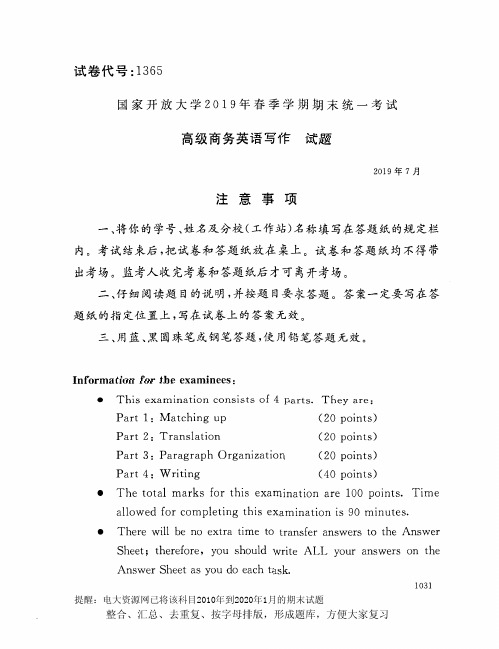
Part 2 Translation (20 points)
Questions 11-15 are based on the following task. Directions: Translate the following sentences into Chinese CEnglish). 11. The respons 心 lities include receiving visitors, scheduling meetings, and writing routine letters and reports. 12. 我期望有机会亲自与您讨论我的资格。 13. Our company is renowned for having the most extensive ranges of products including furniture and handicraft. 14. 我们要感谢您和贵公司近期 300,000 美元的捐款。 15. We are pleased to inform you that we have covered the above shipment with the People's Insurance Company of China against WPA.
(20 points)
Part 3: Paragraph Organization
(20 points)
Part 4: Writing
(40 points)
• The total marks for this examination are 100 points. Time
allowed for completing this examination is 90 minutes.
国家开放大学电大一网平台《商务英语1》一体化考试网考机考交际用语单选题题库及答案
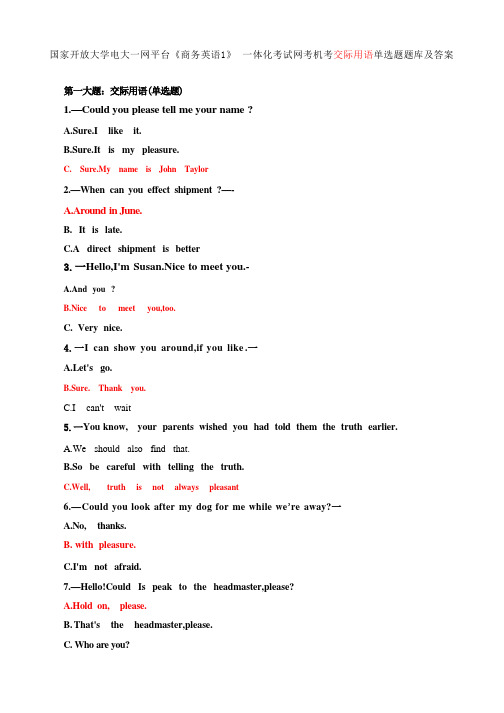
国家开放大学电大一网平台《商务英语1》一体化考试网考机考交际用语单选题题库及答案第一大题:交际用语(单选题)1.—Could you please tell me your name?A.Sure.I like it.B.Sure.It is my pleasure.C.Sure.My name is John Taylor2.—When can you effect shipment?—-A.Around in June.B.It is late.C.A direct shipment is better3.一Hello,I'm Susan.Nice to meet you.-A.And you?B.Nice to meet you,too.C.Very nice.4.一I can show you around,if you like.一A.Let's go.B.Sure.Thank you.C.I can't wait5.一You know,your parents wished you had told them the truth earlier.A.We should also find that.B.So be careful with telling the truth.C.Well,truth is not always pleasant6.—C ould you look after my dog for me while we’re away?一A.No,thanks.B.with pleasure.C.I'm not afraid.7.—Hello!Could Is peak to the headmaster,please?A.Hold on,please.B.That's the headmaster,please.C.Who are you?8.一Happy birthday!A.Thank you.B.The same to you.C.Good luck.9.一Sally,could you lend me your calculator?Mine is not working.A.It doesn't matter.B.No,I can't.C.Sure.10.-We think$55,000 would be reasonable for transferring our trademark.That's too high.A.Oh, my honey.B.0h,my goodness.C.0h, my friend.11.—Oh,I am not feeling wel1.I've got a cold.A.Fine.How are you?B. Never mind.Take care.C.I'm sorry to hear that12.—Linda,you speak English very well.A. No,1 don't think so.B.Thank you very much.C. Not good enough.13.—Kate,could you answer the telephone,please?-I'll get it.A.OK.B. No,thanks.C. Yes, I could.14.—0h,but how long will it take to reach LA?A.It takes along way to reach LA.ually it takes around12days.C. LA is very far from here.15.一Hello,David!1haven't heard from you for along time.How have you been recently?A.That's all right.B.Longtime no see.C.Not bad,thank you.16.一Thank you very much for helping me.A.You're welcome.B.It doesn't matter.C.No need.17.一Hello,Lucy.How are you?-And you?A.Fine,thanks.B.Yes,I amC.Glad to meet you.18.—Help yourself to some fish.A.It sounds nice.B.Thank you.C. Yes,please.19. 一Good morning . Far East Logistics Company . This is Lin Han xue . May I help you? — -A.Good morning,Ms,Lin,Nice to meet you.B.No,thank you.C.Good morning,Ms.Lin.This is Daniel Anderson speaking.20 .—Here you are,Sir .一A. All right,B. Yes,here we are.C.Thank you very much.21.—Would you like to have some rice?A.Yes,please.B. Yes,I like.C.Yes,I have.22.—Nice to see you.-A. Good morning.B.Pleased to meet you,too.C.Nice to see you, too.23.—Would you please give me some water?—A.Yes,1do.B.Certainly,C.No,thanks.24.—Where shall we have the meeting?A.The first conference room is spacious.B.The first conference room isn't good.C.In the first conference room.25.—Well,after my report,there will be a break for refreshments.A.All right,I see.B.The break won't belongC.All right,Ill see it.26 . — Here you are,Sir .一A. All right.B.Yes,here we are.C.Thank you very much.27 . —Well,after my report,there will be a break for refreshments .一A.The break won't belong.B.All right,I see.C. All right,I'1l see it.28.—What if he still doesn't pay up?一A.I have already done that.B.I've got to hurry.C.If it's a small amount we write it off as bad debt.For larger sums we29.—Oh,but how long will it take to reach LA?A.It takes along time to reach LA.ually it takes around 12 days. is very far from here.30.—What's the purpose of your visit today?A.Uh,I'm,not sure.B.I'm intending to ask for your advice on brand design.C.Y es,I'd like to talk with you.31.—Could you give mean example of good team working there?A.Sorry.1can see from your resume.B.Sure.I was the treasurer of the Students’Union.C.Not at all.I was in charge of sales for Corporate Pan-Asia.32.一The senior managers need the results from last month straightaway,so I can't stop totalk.I've got to hurry.A. Stay longer.B.Go slowly.C.0k,see you later.33.一Hello,I'm Susan.Nice to meet you.A.Are you?B.Nice to meet you,too.C.How are you?34.一Sally,could you lend me your calculator?Mine is not working .一A.It doesn't matter,B.No,I can't.C.Sure,why do you need it?35.-1bet that Mike wished you had told him that earlier.一A.We should also find what the customers keep in their minds.B. So be careful with our job.C.Wel1,Mike isn't a fool, he won't do that again.36.—Good morning.Far East Logistics Company.This is Lin Han xue.May I help you?A.Good morning,Ms.Lin.Nice to meet you.B.No,thank you.C.Good morning,Ms.Lin.This is Daniel Anderson speaking.37.一Hello,David!1haven’t heard from you for along time.How have you been recently?A.That's OK.B.Longtime no see.C.Not bad,thank you.38.—Oh.But why didn't he just own up and tell someone?一A.So be careful with our job.B.He was too scared that he would be fired,I suppose.C.You should have told him that earlier.39.—Let me show you how to use the printer.A.I'1l do my best.B.Thanks for your help.C.No,I can use it myself.40.- 1 got to know Ted only from his resume.In fact he is not qualified for his job.A.Oh.it's such a pity!B.Oh,it sounds interesting!C.I'm glad to hear that !41.一Hello,I'm Susan . Nice to meet you .A .And you?一B.Nice to meet you,too.C.Very nice.42.—Could you give me the schedule this afternoon?—A.No problem,Mr.Taylor.B. No,thank you.C. Yes,I can.43.—Do you have any suggestions about it?A.No, l have no idea.B.Let me give you a hand.C.After I read it in detail,Iwill tell you my opinion.44.一1can show you around,if you like .一A.Let's go.B.Sure.Thank you.C.I can't wait.45.—Where shall we have the meeting?A.The first conference room is spacious.B. The first conference room isn't good.C.In the first conference room。
电大4015《商务交际英语(1)》开放大学期末考试试题2019年7月(含答案)

Secondly, all the directors agreed to hold a press conference for the company next month.
by students between 10 and 12 years old. The bank is open for one hour two days a week. Students can put their money into the bank and withdraw it as they wish. Officials from a local bank helped the students start the bank. They trained twenty-three of them to do all the different kinds of bank jobs, from counting money to guarding the bank. The students needed money to start the bank. They raised more than $ 2,000 by selling 50-dollar shares in the bank to parents, teachers, the local bank workers, and customers.
2045国开(电大)2019年7月《金融企业会计 》期末试题及答案

试卷代号:2045国家开放大学2 0 19年春季学期期末统一考试金融企业会计试题注意事项2019年7月一、将你的学号、姓名及分校(工作站)名称填写在答题纸的规定栏内。
考试结束后,把试卷和答题纸放在桌上。
试卷和答题纸均不得带出考场。
监考人收完考卷和答题纸后才可离开考场。
二、仔细读懂题目的说明,并按题目要求答题。
答案一定要写在答题纸的指定位置上,写在试卷上的答案无效。
三、用蓝、黑圆珠笔或钢笔(含签字笔)答题,使用铅笔答题无效。
一、单选题(每题1分,共10分)1.属于当期已经实现的收入和已经发生的费用,不论款项是否收付,都应作为当期的收入和费用,这样的会计核算前提是()。
A.权责发生制B.货币计量C.持续经营D.会计主体2.商业银行办理现金收入必须按()程序处理。
A.先收款,后记账B.先记账,后付款C.先记账,后收款D.先付款,后记账3.客户以现金存入某商业银行,表明某商业银行()。
A.资产负债同时增加B.资产负债同时减少C.资产增加,负债减少D.负债增加,资产减少834.活期储蓄存款的结息日为()。
A.每月30日B.每季末月的20日C. 6月30日D. 12月20日5.某客户签发金额为20 000元的空头转账支票,银行应处以()的罚款。
A. 100 元B. 200 元C. 500 元D. 1 000 元6.()风险最大。
A.抵押贷款B.质押贷款C.信用贷款D.票据贴现7. “清算资金往来”科目,属()科目。
A.资产类B.资产负债共同类C.负债类D.损益类8.取得某项金融资产的目的是为了近期内出售,该金融资产称为()oA.贷款B.交易性金融资产C,持有至到期的投资 D.应收款9.银行汇票的提示付款期限自()起1个月。
A.到期日B.出票日C.承兑日D.交付日10.持票人的付款请求权得不到满足而向其前手请求偿还票据金额的权利,称为()oA.付款请求权B.票据追索权C.付款提示权D.票据承兑权二、多选题(每题2分,共20分)11.反应金融企业财务状况的要素有()oA.资产B.负债C.收入D.权益E.费用F.利润12.企业开立一般存款账户,可以用于()。
国开会计专科《商务英语1》2019秋期末试题与答案.docx
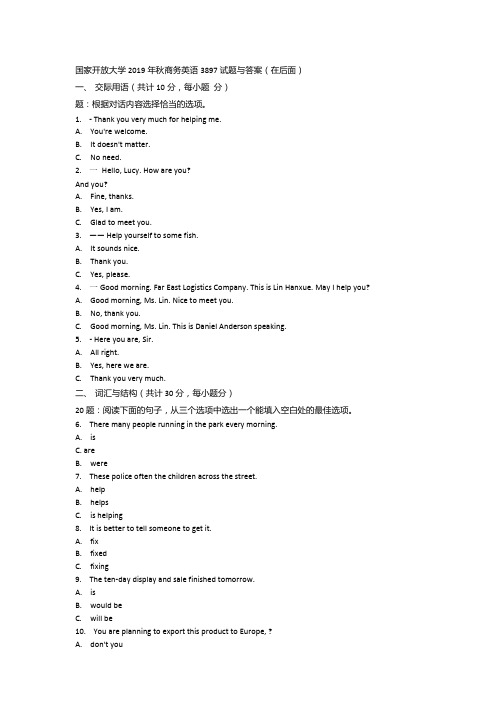
国家开放大学2019年秋商务英语3897试题与答案(在后面)一、交际用语(共计10分,每小题分)题:根据对话内容选择恰当的选项。
1.- Thank you very much for helping me.A.You're welcome.B.It doesn't matter.C.No need.2.一Hello, Lucy. How are you?And you?A.Fine, thanks.B.Yes, I am.C.Glad to meet you.3.—— Help yourself to some fish.A.It sounds nice.B.Thank you.C.Yes, please.4.一Good morning. Far East Logistics Company. This is Lin Hanxue. May I help you?A.Good morning, Ms. Lin. Nice to meet you.B.No, thank you.C.Good morning, Ms. Lin. This is Daniel Anderson speaking.5.- Here you are, Sir.A.All right.B.Yes, here we are.C.Thank you very much.二、词汇与结构(共计30分,每小题分)20题:阅读下面的句子,从三个选项中选出一个能填入空白处的最佳选项。
6.There many people running in the park every morning.A.isC. areB.were7.These police often the children across the street.A.helpB.helpsC.is helping8.It is better to tell someone to get it.A.fixB.fixedC.fixing9.The ten-day display and sale finished tomorrow.A.isB.would beC.will be10.You are planning to export this product to Europe, ?A.don't youB.aren't youC.are youI 1. Markets are the system that some people's demands and some other people's supplies.A.rejectsB.meetsC.bridges12.Small holes should be made in theA.dryC.wet13.I packing in wooden cases.A.PreferB.getC.think14.I'll the remittance f or you m our records.A.check inC. check upB.check out15.Th ere are some visitors to our marketing department next week.eB.to comingmg16.The woolen gloves should in twenty boxes.A.be packedC.be packing17.But the charge will be __ a nd it also slows down delivery.A.more valuableB.cheaperC.higher18.I'd like to know what time we can get the container it is in the port.A.whyB.whenC.where19.The third part is the results.A.expectB.expectingC.expected20.18 of the EU members have replaced their national currencies by Euro notes and corns 2002.A.forB.atC.since三、阅读理解(共计40分,每小题分)2125题:阅读下列短文,从三个选项中选出一个正确答案。
2019年7月中央电大本科《商务谈判策略》期末考试试题及答案
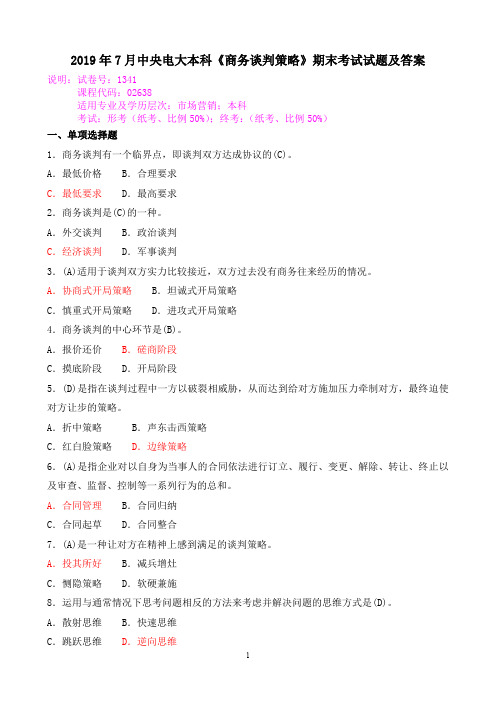
2019年7月中央电大本科《商务谈判策略》期末考试试题及答案说明:试卷号:1341课程代码:02638适用专业及学历层次:市场营销;本科考试:形考(纸考、比例50%);终考:(纸考、比例50%)一、单项选择题1.商务谈判有一个临界点,即谈判双方达成协议的(C)。
A.最低价格 B.合理要求C.最低要求 D.最高要求2.商务谈判是(C)的一种。
A.外交谈判 B.政治谈判C.经济谈判 D.军事谈判3.(A)适用于谈判双方实力比较接近,双方过去没有商务往来经历的情况。
A.协商式开局策略 B.坦诚式开局策略C.慎重式开局策略 D.进攻式开局策略4.商务谈判的中心环节是(B)。
A.报价还价 B.磋商阶段C.摸底阶段 D.开局阶段5.(D)是指在谈判过程中一方以破裂相威胁,从而达到给对方施加压力牵制对方,最终迫使对方让步的策略。
A.折中策略 B.声东击西策略C.红白脸策略D.边缘策略6.(A)是指企业对以自身为当事人的合同依法进行订立、履行、变更、解除、转让、终止以及审查、监督、控制等一系列行为的总和。
A.合同管理 B.合同归纳C.合同起草 D.合同整合7.(A)是一种让对方在精神上感到满足的谈判策略。
A.投其所好 B.减兵增灶C.恻隐策略 D.软硬兼施8.运用与通常情况下思考问题相反的方法来考虑并解决问题的思维方式是(D)。
A.散射思维 B.快速思维C.跳跃思维D.逆向思维9.下列不属于倾听的技巧的是(C)。
A.听取关键词 B.给对方创造发言的机会C.及时纠错 D.反应式倾听10.谈判者的衣着打扮主要依据(C)。
A.个人的兴趣 B.对方的爱好C.场合、年龄、身体、气质 D.个人的习惯二、多项选择题11.一般来说,谈判都要经过以下三个阶段(ACD)。
A.谈判的准备阶段 B.制定谈判计划C.正式谈判阶段 D.谈判的协议执行阶段12.一般而言,模拟谈判的方法包括(ABC)。
A.全景模拟法 B.讨论会模拟法C.列表模拟法 D.头脑风暴法13.影响开局气氛的因素包括(ABC)。
电大1361《国际商务交际》国家开放大学历届试题2019年1月(含答案)

提醒:电大资源网已将该科目2010年到2019年1月的历届试题
提醒:电大资源网已将该科目2010年到2019年1月的历届试题
提醒:电大资源网已将该科目2010年到2019年1月的历届试题
提醒:电大资源网已将该科目2010年到2019年1月的历届试题
提醒:电大资源网已将该科目2010年到2019年1月的历届试题
提醒:电大资源网已将该科目2010年到2019年1月的历届试题
提醒:电大资源网已将该科目2010年到2019年1月的历届试题
提醒:电大资源网已将该科目2010年到2019年1月的历届试题
提醒:电大资源网已将该科目2010年到2019年1月的历届试题。
电大1391《商务英语4》国家开放大学历届试题2019年1月(含答案)

一、交际用语(共计 10 分,每小题 2 分)
1 —5 题:选择正确的语句完成下面对话,井将答案序号写在答题纸上。
1.
—Hey Kyle,
—
guess what! The boss is sending me to Europe for a marketing seminar
next month. You've been itching to go on a business trip for months.
10.
behalf of Vancouver C&S Int'l Trade Corp. , I am pleased to invite you
and your colleagues to visit us.
A. For
C. In
B. On
Hale Waihona Puke 11. While the other people
them. A. interacted C. interviewed
Passage 1
CD
Identify the country or countries you will be travelling to. It is particularly important
to know which countries you are travelling to because it determines where and how you are going to send your application.
A. It's something we should give serious consideration to. B. It will still be a privately held company. C. It will become a privately held company.
2020012140商务交际英语2-国家开放大学2019年秋季学期期末统一考试试题及答案

A. vocal qualities, nonverbal symbols, and visual aids
B. dress, visual aids, and nonverbal symbols
C. statistics, nonverbal symbols, and dress
9. In the opening paragraph of a letter of application,
l. Which of the fo1o1w·ing 1s requ1red in all graphic aids?
八. A title and a so,irce line.
K. 八 title and a graphic. r'--•·• A uni.que number wr re ferencmg purposes. ?. The·vertical axis of a lin,工 chart is
tl,E·time we
,\. bPlicvc the verbal mes 、 age l)'.b e1,.1evc t l1c nonverbal` message
C. believe both of the two kind 、 of languages
0~) ,),)~
Hale Waihona Puke 8. The three main parts of the delivery of an oral presentation a r e ~ .
A. Your mvn experience with the topic of the manual. B, \Vhat rhc ime1飞(如\ readers need ro know. C. What you,入vould like to teach the readers书
2019年电大《商务英语3》期末考试试题及答案

A. circumstances
B. operation
C. case
16. With the rapid economic growth in China, the log 邸 cs industry is _
_
greatly.
A. expanding
B. exploring
C. exploding
important for a new company. Here are some aspects where a leader should be careful not to
make mistakes. 1206
A cohesive (和谐一致的) office culture starts at the top and is built with intention. Facebook's founder projects a laid-back vibe (氛围) . That sets the tone for his $ 200 billion
案序号写在答题纸上。
6. Sometimes your body language, gestures and expressions may tell people
about you than the words you use.
A. more
B. most
C. much
7. Products are graded according to size and
A. I'd like you to meet Joe Stevens. He's our sales team head. The Sales
Department has more than 50 employees.
【2019年7月1391国开电大本科《商务英语4》期末考试试题及答案】

【2019年7月1391国开电大本科《商务英语4》期末考试试题及答案】2019年7月1391国开电大本科《商务英语4》期末考试试题及答案一、交际用语(共计10分,每小题2分) 1-5题:根据对话内容选择恰当的选项,并将答案序号写在答题纸上。
1.―We've done very well so far but if we want to see serious growth,_________. ―Yeah...maybe.But I have my doubts A.it might be time to stick to original business model B.it might be time not to change company model C.it might be time to ditch our old business model and go public [答案]C2.―Thanks for inviting me,John,but I've already made other plans. ―__________Maybe another time. A.I hope you enjoy it.B.That's good.C.Oh!I'm sorry to hear that. [答案]C 3.―Have you ever tried shopping online? ―No,never.__________,especially for clothes and shoes. A.I prefer to actually see and touch what I'm buying before I pay for it B.I prefer not to actually see and touch what I'm buying before I pay for it C.I would rather surf online and I pay for it immediately [答案]A 4.―Aunt Cindy,do you shop online often? ―___________________ A.No,I don't think so. B.That's a good idea. C.Yes.It's very convenient and the price is often lower than in store. [答案]C 5.―Betty,we'll have a buffet party next Saturday.Will you join us? ―_________,Susan.Thank you! A.I'd love to B.I'm afraid not C.By no means [答案]A 二、词汇与结构(共计30分,每小题2分) 6-20题:阅读下面的句子,从A、B、C三个选项中选出一个能填入空白处的正确选项,并将答案序号写在答题纸上 6.That's something you can improve by talking to human_________. A.courses B.resources C.sources [答案]B 7.Then your_________will be sold by auction.A.stiffB.staffC.stuff [答案]C 8.At the same time,the negotiator keeps things secret_________would limit his/her ability to negotiate. A.who B.what C.that [答案]C 9.Travelers,when_________the checks,have to sign the checks in the presence of the bank or service clerks. A.buy B.buying C.to buy [答案]B 10.They wanted to_________a discussion on economics.A.initiativeB.initiateC.initial [答案]B 11.Better understanding of teamwork can make you a more effective employee and give you an extra_________in your corporate office. A.edge B.badge C.age [答案]A 12.It's said that some measures have been taken_________this problem. A.dealing with B.to deal with C.dealt with [答案]B 13.His ideas are linked to the theory_________marketsare efficient,which means market actors taking all available information to create the correct price for things at any given time.A.whichB.whoC.that [答案]C 14.If people_________we're very valuable they won't buy our stock. A.do think B.think C.don't think [答案]C 15.Even though he's_________out of college and still a bit green,he is a great co-worker. A.flesh B.fresh C.flash [答案]B 16.Looking your customers in the eye shows that we are listening to them and hearing_________. A.why are they saying B.how are they saying C.what they are saying [答案]C 17.Some stores even offer_________lanes for customers with 10 items or less to checkout quickly. A.express B.expire C.exact [答案]A 18.Sometimes I surf online shops to check some related information,and then goto a physical store to do the_________shopping. A.virtual B.simulated C.actual [答案]C 19.While the other people_________and discussed the problem together,Ted ignored them. A.interacted B.intensive C.interviewed [答案]A 20.We can't manage that_________you pay for the installation. A.if B.until C.unless [答案]C 三、阅读理解(共计40分,每小题2分) 21-25题:阅读下列短文,从A、B、C三个选项中选出一个正确答案,并将答案序号写在答题纸上。
电大4015《商务交际英语(1)》开放大学期末考试历届试题2020年1月(含答案)
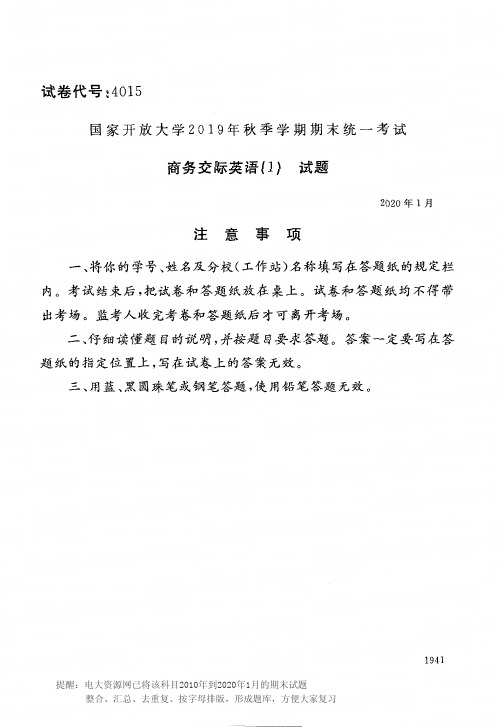
order.
A. direct order
B. indirect order
C. direct-indirect order
II. TRUE/FALSE (10 小题,每小题 2 分,共 20 分)
Write a T in the space provided if the statement is true. Write an F in the space if the
damage to consumers, who spend money but do not get quality commodities, especially
when these commodities do great harm to their health. It is difficult for people to forget
statement is false. Your judgment should be based on your understanding of the course
book.
11. As an employee, it is unlikely that you will have to interact with coworkers and
14. In indirect order, the main idea precedes its supporting information.
15. A paragraph must have at least three sentences to be complete.
16. Use direct order when you expect your reader to react positively to the main idea in
电大1391《商务英语4》开放大学期末考试试题2019年7月(含答案)

案序号写在答题纸上。
6. That's something you can improve by talking to human
.
A. courses
B. resources
C. sources
7. Then your
will be sold by auction.
A. stiff
B. staff
of business is called an individual or sole proprietorship. The proprietor owns all of the property of the business and is responsible for everything.
B. it might be time not to change company model
C. it might be time to ditch our old business model and go public
2. — Thanks for inviting me, John, but I've already made other plans.
A corporation is recognized as an entity-its own legal being, separate from its owners. A board of directors controls corporate policies. The directors appoint top company officers. The directors might or might not hold shares in the corporation. Corporations can have a few major shareholders, or ownership can be spread among the general public. But not all corporations are traditional businesses that sell stock. Some non-profit groups are also organized as corporations.
2019年7月1390国开电大本科《人文英语4》期末考试试题及答案
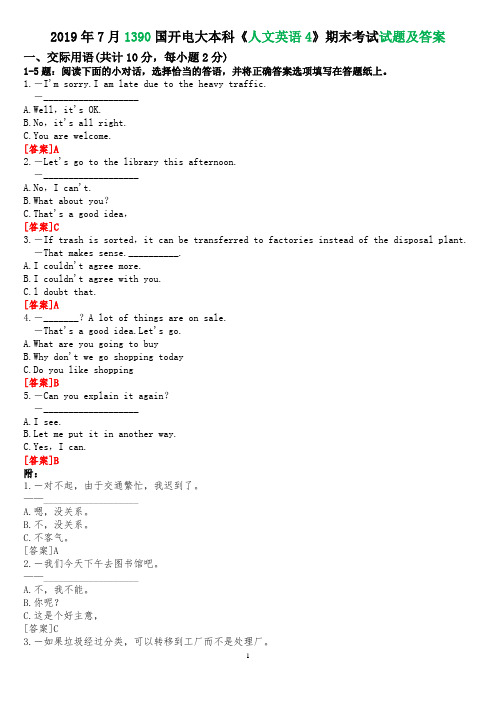
2019年7月1390国开电大本科《人文英语4》期末考试试题及答案一、交际用语(共计10分,每小题2分)1-5题:阅读下面的小对话,选择恰当的答语,并将正确答案选项填写在答题纸上。
1.―I'm sorry.I am late due to the heavy traffic.―___________________A.Well,it's OK.B.No,it's all right.C.You are welcome.[答案]A2.―Let's go to the library this afternoon.―___________________A.No,I can't.B.What about you?C.That's a good idea,[答案]C3.―If trash is sorted,it can be transferred to factories instead of the disposal plant. ―That makes sense.__________.A.I couldn't agree more.B.I couldn't agree with you.C.l doubt that.[答案]A4.―_______?A lot of things are on sale.―That's a good idea.Let's go.A.What are you going to buyB.Why don't we go shopping todayC.Do you like shopping[答案]B5.―Can you explain it again?―___________________A.I see.B.Let me put it in another way.C.Yes,I can.[答案]B附:1.―对不起,由于交通繁忙,我迟到了。
2026国开(电大)2021年7月《国际金融 》期末试题及答案
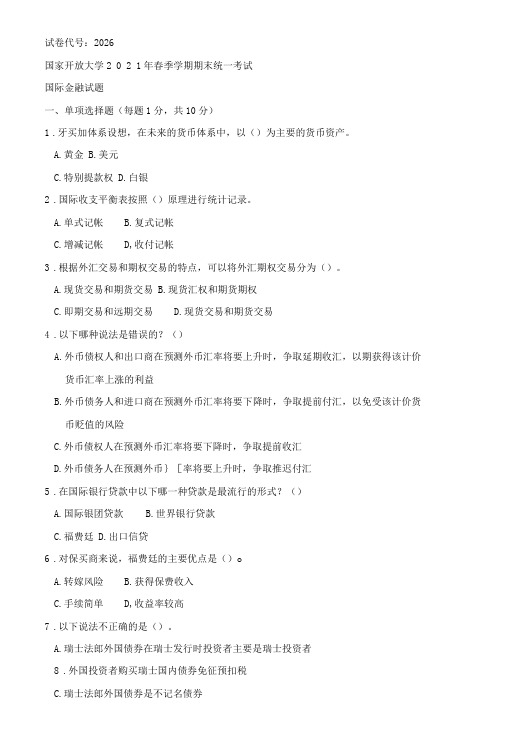
试卷代号:2026国家开放大学2 0 2 1年春季学期期末统一考试国际金融试题一、单项选择题(每题1分,共10分)1.牙买加体系设想,在未来的货币体系中,以()为主要的货币资产。
A.黄金B.美元C.特别提款权D.白银2.国际收支平衡表按照()原理进行统计记录。
A.单式记帐B.复式记帐C.增减记帐D,收付记帐3.根据外汇交易和期权交易的特点,可以将外汇期权交易分为()。
A.现货交易和期货交易B.现货汇权和期货期权C.即期交易和远期交易D.现货交易和期货交易4.以下哪种说法是错误的?()A.外币债权人和出口商在预测外币汇率将要上升时,争取延期收汇,以期获得该计价货币汇率上涨的利益B.外币债务人和进口商在预测外币汇率将要下降时,争取提前付汇,以免受该计价货币贬值的风险C.外币债权人在预测外币汇率将要下降时,争取提前收汇D.外币债务人在预测外币}[率将要上升时,争取推迟付汇5.在国际银行贷款中以下哪一种贷款是最流行的形式?()A.国际银团贷款B.世界银行贷款C.福费廷D.出口信贷6.对保买商来说,福费廷的主要优点是()oA.转嫁风险B.获得保费收入C.手续简单D,收益率较高7.以下说法不正确的是()。
A.瑞士法郎外国债券在瑞士发行时投资者主要是瑞士投资者8.外国投资者购买瑞士国内债券免征预扣税C.瑞士法郎外国债券是不记名债券D.瑞士法郎外国债券的主承销商是瑞士银行8.在国际银团贷款中,银行确定贷款利差的基本决定因素是()。
A.国家风险B.借款人风险C.汇率风险D.预期风险9o最主要的国际金融组织是()oA.世界银行B.国际银行C.美洲开发银行D.国际货币基金组织10.福费廷起源于()的东西方贸易。
A. 50年代B. 60年代C. 70年代D. 80年代二、多项选择题(每题2分,共10分)11.国际收支平衡表中的净误差和遗漏发生的原因包括()。
A.人为隐瞒B.资本外逃C.时间差异D.重复计算E.漏算12.各国政府可以选择的国际收支调节手段包括()等措施。
国际商务交际19.01真题及答案

confhcting cu1tural norms。
Businesses in other countries are also adopting ethics codes and helping employees live
up to the standards。 'Γhe CEC)of a multinati。 nal construction firm has worked v。 ry hard t° rid his company of coⅡ uptio⒒ The battle against bribery in an industry where corruption is rampant hasn’ t been easy。 Yet th。 company experienced success after instaⅡ ing a company lawyer as head of cO【 nphance。
may ease the way for routine government actions, such as expediting a visa request.
More attention is now being paid to the problem of global corroption。 §
problems。
4. Fighting against bribery in an in-ustry is not easy where corruption is coⅡ 1【nonplace。 5. Over thirty years ago, Arnerican government passed a law to prohibit bribery of
商务交际英语试题及参考答案

商务交际英语(1)试题及参考答案试卷代号:2139中央广播电视大学“开放专科”期末考试英语专业商务交际英语(1)试题注意事项一、将你的学号、姓名及分校(工作站)名称填写在答题纸的规定栏内。
考试结束后,把试卷和答题纸放在桌上。
试卷和答题纸均不得带出考场。
二、仔细读懂题目的说明,并按题目要求答题。
答案一定要写在答题纸的指定位置上,写在试卷上的答案无效。
三、用蓝、黑圆珠笔或钢笔答题,使用铅笔答题无效。
I . MULTIPLE CHOICE (10小题,每小题1分,共10分)Choose the letter indicating the best choice to complete each sentence or answer each question:1. Which of the following is an internal barrier to communication?a. the shyness of a person.b. a domineering bossc. a room that is so hot that everyone is impatient with each otherd. all of the above are internal barriers2. Which of the following is a message delivery medium that avoids the problem of "telephone tag"?a. a scannerb. a telephone callc. e-maild. a CPU3. What happens during the first stage of effective team development?a. Team members determine their group goals.b. Team members get acquainted and begin to exchange information.c. The team leader assigns roles to various team members.d. The team learns how to solve problems and overcome conflict.4. What is the main objective of a message that tells the receiver about a new product that wili soon be available in stores?a. To informb. To requestc. To recordd. To persuade5. Which of the following sentences contains a redundant expression?a. Currently we have an overstock of red and blue T-shirts, as of this week.b. As of last quarter, our sales projections were accurate.c. The trend is to underestimate the market value of existing properties.d. Quality is our primary concern, regardless of the impact on production schedules.6. Memos are ______________.a. harder to format and key than lettersb. used to send a message to a supervisor in another companyc. used to send a goodwill message to a coworkerd. usually more formal than business letters7. Abuses of e-mail message writing include ______________.a. spammingb. shoutingc. telecommutingd. both a and b8. Which type of letter is considered a goodwill letter?a. A letter of acknowledgmentb. A positive responsec. A routine requestd. All of the above would be considered a goodwill letter9. Which of the following would be part of an analytical report?a. problem statementb. conclusionsc. recommendationsd. all of the above10. Which of the following is a preliminary part of a formal report?a. bibliographyb. title pagec. both a and bd. neither a nor bII. TRUE/FALSE(10小题,每小题1分,共10分)Write a T in the space provided if the statement is true. Write an F in the space if the statement is false. Your judgment should be based on your understanding of the course book.T/F_______ 11. While computers are becoming smaller and more powerful, they arebecoming more expensive._______ 12. In some cultures, nodding the head means "no" instead of "yes"._______ 13. A heterogeneous group is one that includes people with a mixture ofbackgrounds, abilities, and strengths._______ 14. Only positive messages need to have a positive tone; negative messagescan only be negative in tone._______ 15. Minutes are sent only to the meeting participants._______ 16. Most bad-news messages should be written in the indirect order._______ 17. Letters with negative messages typically open with reasons for thenegative news._______ 18. For a blind copy, the initials be appear on the copy but not on an original._______ 19. Gathering data by talking with customers is called secondary research._______ 20. When writing in a personal style, use the pronouns you and 1.III. ERROR CORRECTION(10分)Rewrite the following short paragraph by identifying all errors and correcting them:Our four-persons committee has met several times to discuss the possibility of flexible scheduling. There has been some good arguments on both sides of the issue, but, unfortunately, we are deadlock in our voting. Would you agree appointing a fifth member to break the tie and help our resolve this important matter? Thank you. IV. READING COMPREHENSION(10小题,每小题2分,共20分)Read the following two passages and answer the questions. Passage One:In the past, the work day was from 9 to 5 and the work week went from Monday through Friday. Rush hour, both morning and evening,was a nightmare as roads became jammed with commuters going to and from the office. While rush hour seems to be here to stay, the traditional work day and work week are gradually becoming a thing of the past.Companies today are facing issues such as office overcrowding and employees" desires, which compel management to be creative in how and where work gets done. Many offices find it beneficial to have flexible working hours. For example, employees may put in their eight hours sometime between the 7:00 a. m. and 6:30 p. m. Others may choose to put in four ten-hour days a week instead of coming to the office five days.Flextime can also help save employers from the expense of expanding an office because of overcrowding. Desirable office space is at a premium in most urban markets, and opening a branch office takes time. Some companies may choose to outsource work, but others do not want to lose creative control. With flextime, more employees can share office space because not everyone is thereat the same time. Whatever a company"s situation, it takes creativity, patience and teamwork to have a pleasant and productive working environment.26. What causes rush hour?a. Commuters not planning well enough.b. Too many people heading for work at one time.c. People"s desire to drive too fast.27. On the whole, employees seem to _____________.a. be reluctant to get involved in deciding when they workb. resent not always working from 9 to 5c. take advantageof creative working arrangements28. What is one advantage of flexible working hours?a. More employees will be at work at the same time.b. Employees will work longer hours.c. Flexibility is cheaper than office expansion.29. According to the passage, desirable office space is _____________.a. expensiveb. hard to findc. very crowded30. Opening a branch office _____________.a. will not help overcrowding problemsb. does not happen overnightc. is bad for businessPassage Two:Most nations of the world export goods to other countries.Likewise, many import goods from other nations. Why do countries engage in international trade?Firstly, some countries of the world have certain conditions that provide them with a basis for international trade. For example,Columbia and Brazil have just the right climate for growing coffee.They export the surplus to earn foreign exchange to pay for the goods they import.Secondly, if a country has an abundance of natural resources, it generally exports some of them. Rubber from Malaysia and oil from the Middle East countries are examples.Thirdly, if a nation is advanced in science and technology, it can produce sophisticated machinery and equipment, such as computers, jet airplanes and electric generators. Their manufactured goods are usually sold at high prices in the international market. So they enjoy favorable conditions in the international trade.In addition to trade in goods, there is another form of trade, i. e.trade in services. The former is called visible trade, and the latter, invisible trade. Transportation, insurance, financing and tourism are some of the forms of invisible trade. Trade in these forms can be as important to some nations as the exchange of goods is to others.31. According to the passage, international trade means_____________.a. exporting goods to other countriesb. exporting goods to and import goods from other countriesc. exchanging not only goods but also service with othercountries32. The reason for countries of the world to engage in international tradeis _____________.a. to build up friendship with people in other countriesb. to exchange what one has for what one needsc. to provide assistance to poor countries33. Saudi Arabia usually exports _____________ to other countries.a. oilb. coffeec. computer34. Who suffer from unfavorable conditions in international trade?a. The developed countries.b. The developing countries.c. The countries in West Europe.35. 10. Which of the following are viewed as invisible trade?a. Coffee, rubber and oil.b. Computers, airplanes and electric generators.c. Transportation, insurance, financing and tourism.V . TRANSLATION (3段短文,每段5分,共15分)Translate the following passages into Chinese:36. successful teams are made up of individuals who have differentbackgrounds. In an organization, effective work teams have to bebased on function, purpose, or individual expertise rather than onpersonality.37. To cut down in wordiness, use the active voice rather than thepassive voice. Using the active voice helps you be direct and keeps your sentences from being too wordy.38. Formal reports are more complex and longer than informal reports.Because of this complexity, you may spend more time organizing and writing a formal report than you would prepare an informal report.Formal reports may be used when writing to the top management of an organization.VI. WRITING (35分)39. According to the given facts, format a business envelope: (5分)The sender:Kang Zhuang, General Manager of FORWARD BICYCLE CO. LTD.987 Jiangnan Road, Kunshan, Jiangsu, China, 215300Tel; (0520)5000000Fax; (0520)5000001The receiver:Mr. Fred Johns, Chief Buyer of Kiddie Komer, Inc.# 202-418 Richards Street, Vancouver, B. C. Canada V6S 3A740. Write a correctly laid out memo according to the following. (10分)Jane Simmons, Personnel Manager of Alpha Electronics,80 - 90 Zeus Street, Manchester GG73 6LP, says to you, "Will youwrite a memo for me to Simon Clark, my deputy, please?When he returns from holiday next Monday I shall be starting a three-day conference at Harogate. Ask him to interview the four candidates for the clerical vacancy in the Mailing Section on Monday, starting at 2 :30 p. m. He should make an appointment if there is a suitable candidate. The candidates have been invited for interview and their application forms and references are in the middle drawer of my desk. I" 11 leave my desk keys with you. On Tuesday at 10 a. m. Gerry Rhodes, the Union Rep, has an appointment to see me. If Simon I can deal with whatever he wants, I shall be grateful. If not, I"ll make another appointment to see Gerry when I"m back on Tuesday. "41. Write a letter according to the situation below, using the block format and open punctuation. (20分)Situation: Two months ago you contacted a Scottish company, the Organisers of Scottish Exhibitions (OSE), based at 9 Rider Street, Charlestown, CH3 MN1, to organize a 3-day exhibition of your products in Glasgow. The exhibition took place last week andyou have heard from your staff and customers that it was a disaster because of the inefficient planning of the deputy director of OSE, Barbara Minter.Write a letter to Mrs. Minter, describing what went wrong, the consequences for your company and what you want. Make up any necessary details.参考答案及评分标准I. MULTIPLE CHOICE (10小题,每小题1分,共10分)Choose the letter indicating the best choice to complete each sentence or answer each question:1. a2. c3. b4. d5. a6. c7. d8. a9.d 10. bII. TRUE/FALSE (10小题,每小题1分,共10分)Write a T in the space provided if the statement is true. Write anF in the space if the statement is false.11. F 12. T 13. T 14. F 15. F16. T 17. F 18. T 19.F 20. TIII. ERROR CORRECTION (10分)Rewrite the following short paragraph by identifying all errors and correcting them:Our four-person committee has met several times to discuss the possibility of flexible scheduling. There have been some good arguments on both sides of the issue, but, unfortunately, we are deadlocked in our voting. Would you agree to appointing a fifth member to break the tie and help us resolve this important matter? Thank you.评分标准:短文中有5个错,找出错误5分;改正错误5分。
[2019年7月国开(中央电大)本科《商务英语3》期末考试试题及答案] 电大商务英语3答案
![[2019年7月国开(中央电大)本科《商务英语3》期末考试试题及答案] 电大商务英语3答案](https://img.taocdn.com/s3/m/0af70ace31b765ce04081498.png)
[2019年7月国开(中央电大)本科《商务英语3》期末考试试题及答案] 电大商务英语3答案2019年7月国开(中央电大)本科《商务英语3》期末考试试题及答案说明:试卷号码:1380;适用专业:会计学、金融学、市场营销和物流管理本科。
试卷代号:13 80 国家开放大学2 0 1 9年春季学期期末统一考试商务英语3 试题答案及评分标准(供参考)2019年7月一、交际用语(共计10分,每小题2分)1-5题:选择正确的语句完成下列对话,并将答案序号写在答题纸上。
1.C 2.A 3.C 4.C 5.B 二、词汇与结构(共计30分,每小题2分)6-20题:阅读下面的句子,从A、B、C三个选项中选出一个能填入空白处的正确选项,并将答案序号写在答题纸上。
6.C 7.A 8.A 9.C 10.B 11.A 12.B 13.C 14.B 15.A 16.A 17.B 18.A 19.C 20.B 三、阅读理解(共40分,每小题4分)21-25题:阅读短文,从A、B、C三个选项中选出一个正确答案,并将答案序号写在答题纸上。
21.C 22.A 23.C 24.B 25.A 26-30题:根据短文内容判断给出的语句是否正确,正确的写“T”,错误的写“F”,并将答案写在答题纸上。
26.F 27.F 28.T 29.T 30.T 四、写作(共20分)31.根据要求写作文。
作文评分标准(1)评分原则①本题总分为20分,按6个档次给分。
1132 ②评分时,先根据文章的内容和语言初步确定其所属档次,然后以该档次的要求来衡量、确定或调整档次,最后给分。
③评分时应注意的主要内容为:内容要点、句型变化、词汇运用、语法结构的准确性,语意的连贯性和逻辑性以及应用文的格式要求。
④评分时,如拼写错误较多,书写较差,以至影响交际,将分数降低一个档次。
(2)各档次的给分范围和要求感谢您的阅读!。
- 1、下载文档前请自行甄别文档内容的完整性,平台不提供额外的编辑、内容补充、找答案等附加服务。
- 2、"仅部分预览"的文档,不可在线预览部分如存在完整性等问题,可反馈申请退款(可完整预览的文档不适用该条件!)。
- 3、如文档侵犯您的权益,请联系客服反馈,我们会尽快为您处理(人工客服工作时间:9:00-18:30)。
国家开放大学 2 0 1 9 年春季学期期末统一考试 国际商务交际 试题
2019 年 7 月
注意事项
一、将你的学号、姓名及分校(工作站)名称填写在答题纸的规定 栏内。考试结束后,把试卷和答题纸放在桌子上。试卷和答题纸均不 得带出考场。监考人收完考卷和答题纸后才可离开考场。
二、仔细读懂题目的说明,并按题目要求和答题示例答题。答案一 定要写在答题纸的指定位置上,写在试卷上的答案无效。
1015
提醒:电大资源网已将该科目2010年到2020年1月的期末试题
整合、汇总、去重复、按字母排版,形成题库,方便大家复习
Remember, too, that some cultures prefer greater formality than Americans exercise. Instead of first names, use only honorifics (Mr. or Ms.) and last names, as well as
When working with an interpreter, you must be very careful about your language. For example, you will need to express ideas in small chunks to give the interpreter time to translate. You may need to slow down as you speak and stop after each thought to allow time for the translation that will follow. Even if your presentation or speech is being translated simultaneously, remember to speak slowly and to pause after each sentence to ensure that your message is rendered correctly in the target language.
anticipate expectations and perceptions that may differ significantly from what you may consider normal. For example, emphasis on getting to the point quickly is not equally prized across the globe. Many people (notably those in Japanese, Latin American, and Arabic cultures) consider such directness to be brash and inappropriate.
laughing in a business presentation. Their expectation is of a rational-that is, "serious"—
fact-based delivery. American-style enthusiasm is often interpreted abroad as hyperbolic
academic or business titles—such as Doctor or Director. Writing on a flipchart or
transparency seems natural and spontaneous in this country. Abroad, though, such informal techniques may suggest that the speaker dugh to prepare proper visual aids in advance. Mark the following statements True or False according to the information provided in the text.
exaggeration or, worse, as dishonesty and can lead to misunderstandings. If an American
says "Great job!" to offer praise, a Spanish counterpart might believe the American has approved the project. "When Europeans realize there's no commitment implied," warned an intercultural consultant, "they might feel deceived or that the American is being superficial. "
提醒:电大资源网已将该科目2010年到2020年1月的期末试题
整合、汇总、去重复、按字母排版,形成题库,方便大家复习
Part Three Writing (60 points)
I . Revise each of the following sentences according to the requirement given in the brackets.
The same advice is useful in organizing presentations. Consider breaking your presentation into short, discrete segments. You may want to divide your talk into distinct topics, developing each separately and encouraging discussion periods after each. Such organization enables participants to ask questions and digest what has been presented.
三、用蓝、黑圆珠笔或钢笔答题,使用铅笔答题无效。
1014
提醒:电大资源网已将该科目2010年到2020年1月的期末试题
整合、汇总、去重复、按字母排版,形成题库,方便大家复习
Part One Reading (20 points) In addressing intercultural audiences when you are giving a presentation, you need to
Match your presentation and your nonverbal messages to the expectations of your audience. In Germany, for instance, successful presentations tend to be dense with facts and precise statistics. Americans might say "around 30 percent" whereas a German presenter might say "30. 4271 percent. "Similarly, constant smiling is not as valued in Europe as it is in North America. Many Europeans distrust a speaker who is cracking jokes, smiling, or
Please write your revised version in the Answer Sheet. (30 points) 15. This letter is to inform you of an important change in our policy concerning msurance. to emphasize you" attitude) 16. Every employee is entitled to see his personnel file. (to eliminate language bias) 17. You won't be disappointed with the many electronic services we now offer. (to make it positive) 18. Reference is made to your May 7 letter in which you described the approved procedure for initiating a claim. (to make it conversational) 19. It has been determined by the staff that our process of checking verification for customers must be simplified. (to make it simple and clear) 20. In accordance with your wishes, we are sending you under separate cover two contract forms. (to make it concise) 21. I understand that you offer employee testing materials, and I have a number of questions to ask. (to improve the directness) 22. Your letter claims that you returned a defective headset. (to adopt a positive expression) 23. Come join our company, where the pay is high, working conditions are pleasant, and to succeed is possible. (to improve parallelism) 24. Members of the team have taken into consideration every one of the factors that has the capacity to affect the purchase. (to improve the vigor and directness)
